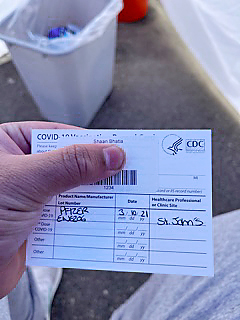
It’s been over a year since covid-19 forced almost everyone into mandatory quarantine. The lines defining our daily lives have blurred.
Busy malls have become ghost towns. Arenas that were packed with fans are now just empty shells of what they used to be. The routines of our normal lives seem like a thing of the past.
But all it takes is two shots in the arm to return back to normal.
Whether you have outlandish views such as “vaccines create autism” or reasonable views such as “the creation of the vaccines were rushed”; you should still take the vaccine.
Nearly $9 billion has been invested into vaccine research and development and while the rush to create a vaccine was a popular concern amongst Americans, the Centers for Disease Control and Prevention (CDC) made information regarding development easily accessible to the public. At each stage, numerous tests were conducted and required approval by multiple researchers, doctors and officials.
While I feel the CDC has done a great job at making sure the vaccines are effective and safe, our federal government has done a poor job at distribution and administration of the doses.
I definitely agree those who are most at risk should get the vaccine first. This includes police officers, firefighters, military members, healthcare workers, the elderly and those who have underlying medical conditions.
The prioritization of those in the food industry over teachers and students is concerning. I am not saying that those in the food industry are any less important than everyone else, but the need to get schools fully reopened is far more important.
Students are missing out on important lessons because teachers have been forced to reduce the amount of time they can devote to online lessons. The school day has been reduced by more than two hours and classes only meet two days a week instead of five. . High school students are being shortchanged. are undergoing their most important years before college and the information they are losing out on are what some consider to be fundamental for the rest of their lives. Preschool and elementary students are losing out on valuable social skills that can only be learned by interacting with their classmates in a class.
Getting teachers and students back in classrooms is important. Vaccines are the answer.
I am someone who would like to be back in class and participate in extracurricular activities with no fear of catching the virus and transmitting it to members of my family. I want to resume hangouts with my friends without worrying about masks and social distancing, so I decided I would get the vaccine.
The first and most difficult step in getting the vaccine was scheduling an appointment. It took about a week and I had to repeatedly refresh California’s Department of Public Health website, myturn.com, the appointment scheduling site. After several error messages and unavailable appointment times, I finally got a text confirming my appointment.
I got my first dose of the Pfizer vaccine on March 10. When I arrived at the vaccination site there were foldable chairs, tents and long lines. When it was my turn, volunteers asked me to present them with an email confirming my appointment and a recent pay stub along with a letter from my employer as proof I worked in the food industry. They immediately directed me to the chairs behind them.
They asked me to keep my mask on and present a valid driver’s license proving I was old enough to get the Pfizer vaccine, which is the only shot available to those 16 and older. The staff offered everyone water while they waited. Again I had to present the required documents and give my address, age and proof of employment.
Next, a nurse numbed my shoulder. I was able to get a good look at the needle. Although I typically get nervous and hate getting shots I was eager to watch as the needle penetrated the skin and the vaccine dose was injected into my shoulder. The shot felt no different than getting an annual flu shot at the doctor’s office. After injecting me, the nurse filled out the CDC’s vaccine information card and handed it to me to present when I got my second shot.
Next was a 15-minute supervised wait period to see if I would show any adverse symptoms. All the seats were socially distanced, with nurses checking on those whose wait time was almost completed. When I asked a nurse if I could take pain relievers such as Advil, They advised me to stay away from pain relievers, since they might reduce the effectiveness of the first dose. When the wait was over I was able to leave and head home. My only side effect was a sore arm that lasted for less than a week.
Although the process was nerve racking and required a lot of patience, it was worth it.
It means I’m one step closer to getting back to my normal routine.


